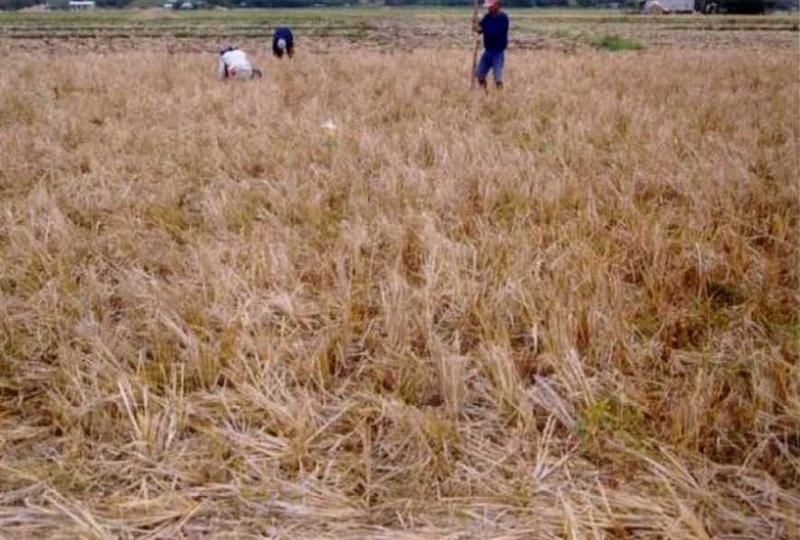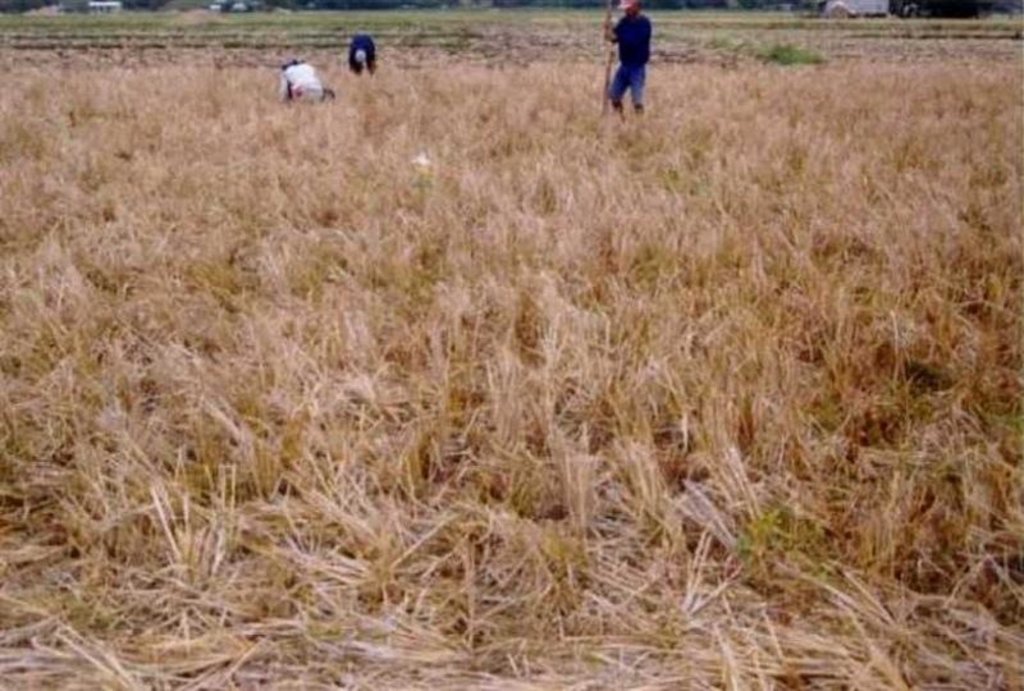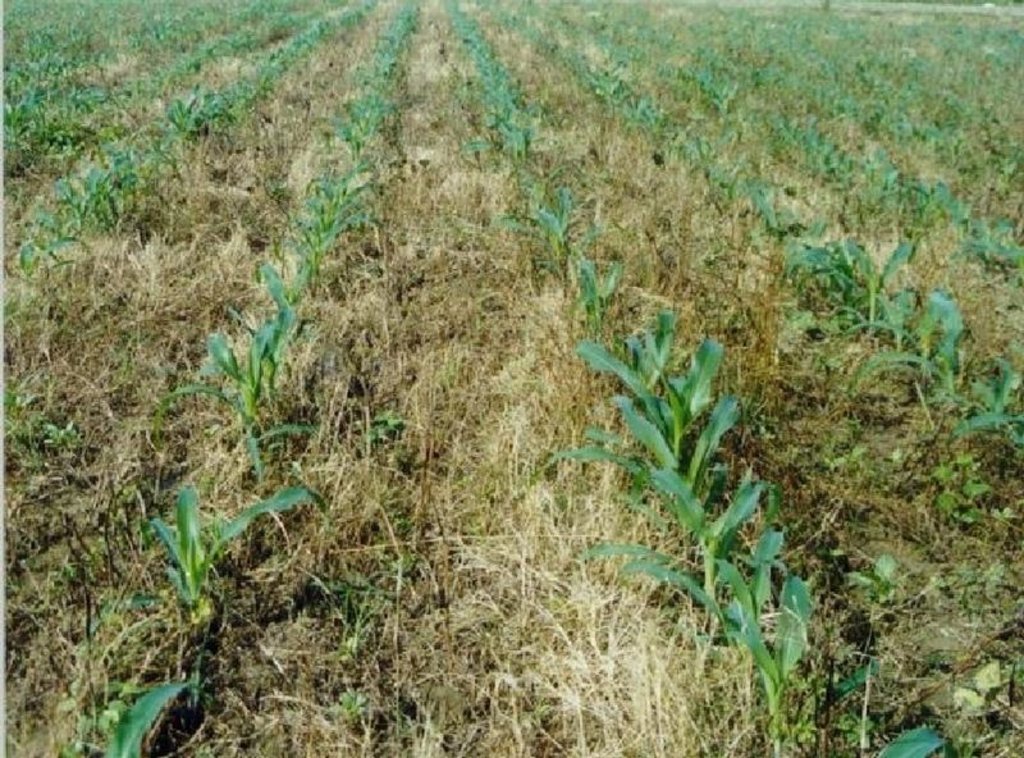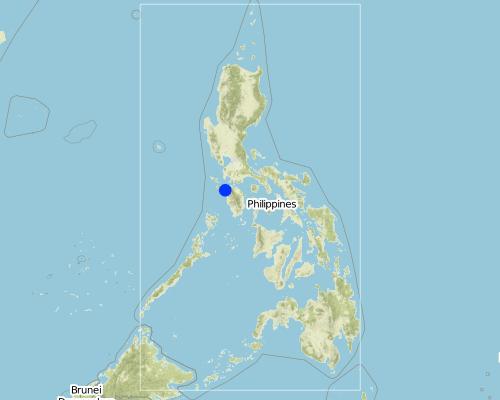Conservation Tillage Practices for Corn Production [菲律宾]
- 创建:
- 更新:
- 编制者: Philippine Overview of Conservation Approaches and Technologies
- 编辑者: –
- 审查者: David Streiff
"Tipid Saka"
technologies_1021 - 菲律宾
查看章节
全部展开 全部收起1. 一般信息
1.2 参与该技术评估和文件编制的资源人员和机构的联系方式
Jasper Manalo
jasper.o.manalo@monsanto.com
Monsanto Philippines
菲律宾
SLM专业人员:
Edicer Ocampo Jr
6349 536 4455
edicer@lycos.com
FSSRI, http://www.uplb.edu.ph/research/research-centers
菲律宾
有助于对技术进行记录/评估的机构名称(如相关)
Farming Systems and Soil Resources Institute, University of the Philippines Los (Farming Systems and Soil Resources Institute, University of the Philippines Los) - 菲律宾有助于对技术进行记录/评估的机构名称(如相关)
Monsanto Philippines Inc. - 菲律宾1.3 关于使用通过WOCAT记录的数据的条件
(现场)数据是什么时候汇编的?:
04/09/2001
编制者和关键资源人员接受有关使用通过WOCAT记录数据的条件。:
是
2. SLM技术的说明
2.1 技术简介
技术定义:
Conservation Tillage Technology (Zero Tillage) or "Tipid Saka" - A crop production system which focuses on soil conservation and reducing excessive tillage operations, reduces labor and farm inputs while increasing productivity and profitability
2.2 技术的详细说明
说明:
Brief Description about Conservation Tillage Technology
Conservation tillage is the practice of planting seeds through the stubble of last season’s crop, rather than plowing and disking the field. The stubble protects topsoil against loss to wind and rain and reduces chemical run-off to streams. By not plowing, farmers also conserve soil moisture, which can reduce irrigation demands. Farmers can save fuel by reducing the number of farm machinery passes across their fields. In simple terms, Conservation Tillage can be said to lie along a continuum of two other techniques:
Minimum Tillage - mouldboard plowing is replaced by light tillage with tined implements, with or without a low toxicity non-residual herbicide to eliminate both perennial and annual weeds. 30% or more of the soil surface is kept covered by soil residues until final seedbed preparation. Conventional planting equipment can normally be used. Zero Tillage - planting is normally conducted without any preparatory tillage, or seedbed preparation. Normally, this technique requires specialized machinery for planting which can displace residues from the previous crop. A low toxicity non-residual herbicide application is recommended where growing weeds are present. There are numerous potential advantages of conservation tillage:
Farming Benefits
For farmers the primary benefits of CT, achieved with any loss of yields, include:
- More sustainable farming due to dramatic reductions in soil erosion caused by water or wind
- More efficient conservation and utilization of water under dryland conditions
- Improved energy efficiency as a result of reduced fuel requirements associated with fewer field operations
- Greater crop and farm profitability through reduced direct and indirect costs for chemicals, fuel and labor.
Environmental Benefits
At the same time, CT offers a number of significant benefits to the environment, these include:
- Greater biodiversity than with standard cultivation practices where the surface has no crop residues
- Reduces the build-up of soil sediments in reservoirs, drainage, ditches, etc. caused by soil erosion
- Less pollution of drinking water sources caused by run-off of soil, fertilizers and pesticides
- Reduced CO2 emissions due to increased soil organic matter level
Furthermore, crops grown without tillage use water more efficiently, the water-holding capacity of the soil increases, and water losses from runoff and evaporation are reduced. For crops grown without irrigation in drought-prone soils, this more efficient water use can translate into higher yields. In addition, soil organic matter and populations of beneficial insects are maintained, soil and nutrients are less likely to be lost from the field and less time and labor is required to prepare the field for planting. In general, the greatest advantages of reduced tillage are realized on soils prone to erosion and drought. Also achieved are greater water-stability of surface soil aggregates, higher microbial activity and earthworm populations and higher total carbon. Soil loss is less from sprinkler irrigation than in the plow treatment.
2.3 技术照片
2.5 已应用该技术的、本评估所涵盖的国家/地区/地点
国家:
菲律宾
区域/州/省:
Laguna
有关地点的进一步说明:
San Jose, Abra de Ilog, Sta. Cruz, Sablayan
注释:
"Tipid Saka" is being practiced by farmers in the sites of San Jose, Mindoro Occidental since the dry season cropping (1999-2000) with the entry of UPLB Corn project and Monsanto Philippines, Inc.
Map
×2.6 实施日期
如果不知道确切的年份,请说明大概的日期:
- 不到10年前(最近)
2.7 技术介绍
详细说明该技术是如何引入的:
- 通过项目/外部干预
注释(项目类型等):
Although the technology has long been practiced by farmers particularly in the upland areas, zero tillage practices for corn production after rice was introduced in the SWC sites of Mindoro Occidental by the UPLB Corn project through the "Tipid Saka technology of Mosanto Philippines, Inc.
3. SLM技术的分类
3.2 应用该技术的当前土地利用类型

农田
- 一年一作
主要农作物(经济作物及粮食作物):
major cash crop: rice, corn
major food crop: rice, vegetables
other: fruits, tobacco
注释:
Major land use problems (compiler’s opinion): Continuous salinization due to intrusion of salt water and soil fertility decline. Loss of topsoil by water erosion seriously affects soil productivity, degrades water quality and causes costly sedimentation problems.
Major land use problems (land users’ perception): Soil productivity decline; need more inputs to maintain and increase crop yield.
Type of cropping system and major crops comments: Generally, first crop of rice is planted in early part of June nad harvest in mid October. Followed by green corn and/or vegetables in November and harvested in February. Yellow corn is planted in December and harvested in March to April.
3.3 有关土地利用的更多信息
该技术所应用土地的供水:
- 雨养
注释:
Also mixed rainfed - irrigated is common but less used than rainfed
每年的生长季节数:
- 2
具体说明:
Longest growing period in days: 150Longest growing period from month to month: Jun - OctSecond longest growing period in days: 120Second longest growing period from month to month: May - Sep
3.4 该技术所属的SLM组
- 最小的土壤扰动
- 灌溉管理(包括供水、排水)
- cost reduction
3.5 技术传播
具体说明该技术的分布:
- 均匀地分布在一个区域
如果该技术均匀地分布在一个区域上,请注明覆盖的大致区域。:
- 100-1,000 平方千米
注释:
Total area covered by the SLM Technology is 100 m2.
3.6 包含该技术的可持续土地管理措施
3.7 该技术强调的主要土地退化类型

土壤水蚀
- Wt:表土流失/地表侵蚀

化学性土壤退化
- Cn:肥力下降和有机质含量下降(非侵蚀所致)

水质恶化
- Ha:干旱化
注释:
Main type of degradation addressed: Cn: fertility decline and reduced organic matter content
Secondary types of degradation addressed: Wt: loss of topsoil / surface erosion, Ha: aridification
3.8 防止、减少或恢复土地退化
具体数量名该技术与土地退化有关的目标:
- 防止土地退化
- 减少土地退化
注释:
Main goals: prevention of land degradation
Secondary goals: mitigation / reduction of land degradation
4. 技术规范、实施活动、投入和成本
4.2 技术规范/技术图纸说明
Technical knowledge required for field staff / advisors: low
Technical knowledge required for land users: low
Mulching
Material/ species: crop residues, rice stubbles
Remarks: crop residues serve as mulching materials once killed by POWER herbicide
Zero tillage / no-till
Remarks: application of POWER herbicide 7-10 days after irrigation
4.3 有关投入和成本计算的一般信息
具体说明成本和投入是如何计算的:
- 每个技术区域
具体说明成本计算所用货币:
- 美元
注明雇用劳工的每日平均工资成本:
5.00
4.5 技术建立所需要的费用和投入
| 对投入进行具体说明 | 单位 | 数量 | 单位成本 | 每项投入的总成本 | 土地使用者承担的成本% | |
|---|---|---|---|---|---|---|
| 劳动力 | Labour vouluntarily and paid | ha | 1.0 | 147.6 | 147.6 | 100.0 |
| 劳动力 | post harvest | ha | 1.0 | 200.0 | 200.0 | |
| 植物材料 | seed | ha | 1.0 | 30.0 | 30.0 | 100.0 |
| 肥料和杀菌剂 | fertilizer | ha | 1.0 | 60.0 | 60.0 | 100.0 |
| 肥料和杀菌剂 | biocides | ha | 1.0 | 1.6 | 1.6 | 100.0 |
| 肥料和杀菌剂 | BIO-N | ha | 1.0 | 2.0 | 2.0 | 100.0 |
| 其它 | man person days | ha | 1.0 | 70.0 | 70.0 | 100.0 |
| 其它 | marketing: transportation | ha | 1.0 | 20.0 | 20.0 | 100.0 |
| 其它 | marketing: packaging | ha | 1.0 | 10.0 | 10.0 | 100.0 |
| 技术建立所需总成本 | 541.2 | |||||
注释:
Duration of establishment phase: 0 month(s)
4.6 维护/经常性活动
| 活动 | 措施类型 | 时间/频率 | |
|---|---|---|---|
| 1. | 1st side dressing, Release of trichogramma | 农业学的 | early vegetative stage / each cropping season |
| 2. | 2nd side dressing, Off-barring and hilling-up | 农业学的 | vegetative stage / each cropping season |
| 3. | Detasseling | 农业学的 | late vegetative stage / each cropping season |
| 4. | Spray POWER herbicide, Planting | 农业学的 | onset of rainy season / each cropping season |
| 5. | Retouch application of POWER herbicide, Replanting | 农业学的 | onset of rainy season / each cropping season |
4.7 维护/经常性活动所需要的费用和投入(每年)
注释:
Machinery/ tools: plow, harrow, hand tractor
Per hectare of land
4.8 影响成本的最重要因素
描述影响成本的最决定性因素:
Land cultivation- zero tillage offset the costs incurred during land preparation. Labor costs for hand tractor and carabao-drawn plows are substituted by costs of spraying POWER herbicide which is significantly less expensive
5. 自然和人文环境
5.1 气候
年降雨量
- < 250毫米
- 251-500毫米
- 501-750毫米
- 751-1,000毫米
- 1,001-1,500毫米
- 1,501-2,000毫米
- 2,001-3,000毫米
- 3,001-4,000毫米
- > 4,000毫米
指定年平均降雨量(若已知),单位为mm:
450.00
农业气候带
- 潮湿的
- 半湿润
Thermal climate class: tropics
5.2 地形
平均坡度:
- 水平(0-2%)
- 缓降(3-5%)
- 平缓(6-10%)
- 滚坡(11-15%)
- 崎岖(16-30%)
- 陡峭(31-60%)
- 非常陡峭(>60%)
地形:
- 高原/平原
- 山脊
- 山坡
- 山地斜坡
- 麓坡
- 谷底
垂直分布带:
- 0-100 m a.s.l.
- 101-500 m a.s.l.
- 501-1,000 m a.s.l.
- 1,001-1,500 m a.s.l.
- 1,501-2,000 m a.s.l.
- 2,001-2,500 m a.s.l.
- 2,501-3,000 m a.s.l.
- 3,001-4,000 m a.s.l.
- > 4,000 m a.s.l.
说明该技术是否专门应用于:
- 不相关
关于地形的注释和进一步规范:
Landfroms: Area has generally flat topography located along wide plains.
Slopes: Small isoloated areas have slope of 0-2%
5.3 土壤
平均土层深度:
- 非常浅(0-20厘米)
- 浅(21-50厘米)
- 中等深度(51-80厘米)
- 深(81-120厘米)
- 非常深(> 120厘米)
土壤质地(表土):
- 中粒(壤土、粉土)
表土有机质:
- 中(1-3%)
如有可能,附上完整的土壤描述或具体说明可用的信息,例如土壤类型、土壤酸碱度、阳离子交换能力、氮、盐度等。:
Soil texture is medium andtextural analysis of samples show that the soils are silt loam.
Soil feritlity is low and the areas have high potential soil salinity problem.
The soil water storage has a capcity of 53.66% to 77.53% .
5.6 应用该技术的土地使用者的特征
生产系统的市场定位:
- 混合(生计/商业
非农收入:
- 收入的10-50%
相对财富水平:
- 贫瘠
- 平均水平
机械化水平:
- 畜力牵引
- 机械化/电动
说明土地使用者的其他有关特征:
Population density: 50-100 persons/km2
Annual population growth: 3% - 4%
and own 15% of the land.
5% of the land users are average wealthy and own 45% of the land.
70% of the land users are poor and own 25% of the land.
25% of the land users are poor and own 15% of the land.
Off-farm income specification: Carpentry, plumbing, business, offer of labor services to neighbors
Market orientation of production system: mixed (subsistence and commercia (Corn)l: Sold to feed millers, surplus is kept for next cropping.
Level of mechanisation: Rich farmers can afford to rent trators but Carabao-drawn plow is still dominant among averaged income farmers.
5.7 应用该技术的土地使用者拥有或租用的平均土地面积
- < 0.5 公顷
- 0.5-1 公顷
- 1-2 公顷
- 2-5公顷
- 5-15公顷
- 15-50公顷
- 50-100公顷
- 100-500公顷
- 500-1,000公顷
- 1,000-10,000公顷
- > 10,000公顷
这被认为是小规模、中规模还是大规模的(参照当地实际情况)?:
- 小规模的
注释:
2-5 ha also common but lowest ranked
5.8 土地所有权、土地使用权和水使用权
土地所有权:
- 个人,未命名
土地使用权:
- 租赁
6. 影响和结论性说明
6.1 该技术的现场影响
社会经济效应
生产
作物生产
收入和成本
农业收入
工作量
其它社会经济效应
input constraints
社会文化影响
SLM/土地退化知识
冲突缓解
生态影响
水循环/径流
多余水的排放
土壤
土壤水分
土壤流失
SLM之前的数量:
10
SLM之后的数量:
2
土壤压实
减少气候和灾害风险
洪水影响
风速
其它生态影响
soil fertility
6.4 成本效益分析
技术收益与技术建立成本相比如何(从土地使用者的角度看)?
短期回报:
积极
长期回报:
非常积极
技术收益与技术维护成本/经常性成本相比如何(从土地使用者的角度看)?
短期回报:
非常积极
长期回报:
非常积极
6.5 技术采用
- 10-50%
如若可行,进行量化(住户数量和/或覆盖面积):
300 households
在所有采用这项技术的人当中,有多少人是自发地采用该技术,即未获得任何物质奖励/付款?:
- 90-100%
注释:
20% of land user families have adopted the Technology without any external material support
300 land user families have adopted the Technology without any external material support
Comments on spontaneous adoption: estimates
There is a strong trend towards spontaneous adoption of the Technology
Comments on adoption trend: Multinational company such as Monsanto Philippines, Inc. Continuously disseminate the technology through promotion of POWER herbicide
6.7 该技术的优点/长处/机会
| 土地使用者眼中的长处/优势/机会 |
|---|
| Easy to establish and maintain |
| Improved production efficiency |
| 编制者或其他关键资源人员认为的长处/优势/机会 |
|---|
| Easy to establish and maintain |
| Improved production efficiency |
| Increase soil water storage |
6.8 技术的弱点/缺点/风险及其克服方法
| 土地使用者认为的弱点/缺点/风险 | 如何克服它们? |
|---|---|
| Soil compaction and flooding |
| 编制者或其他关键资源人员认为的弱点/缺点/风险 | 如何克服它们? |
|---|---|
| Soil compaction and flooding |
7. 参考和链接
7.2 参考可用出版物
标题、作者、年份、ISBN:
Labios, R.V. Et al. 200-2002," Conservation Tillage Practices in Corn Production After Rice: A Case in San Jose, Mindoro Occidenta"l. Pamhplet published by UPLB, DA-BAR, and National Corn RDE Network. P33
标题、作者、年份、ISBN:
Labios, R.V., Robles, A.Y., Javier, P.A., Garcia, M.U., Gonzales, P.G., Luis, E.M., Labios, J.D., Medina, C.M., Valencia, G.Z., Tamisin, L.L., Ocampo, E.P. Jr., Miciano, D.M. 1999. Annual Report. Enhancing Adaptation and Utilization of Location Sp
标题、作者、年份、ISBN:
Manalo, J.O. 2000. Tipid Saka Technology. Monsanto Philippines, Inc. 7th Floor Ayala Life FGU Center, Madrigal Business Park, Alabang, Muntinlupa City.
链接和模块
全部展开 全部收起链接
无链接
模块
无模块





